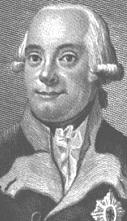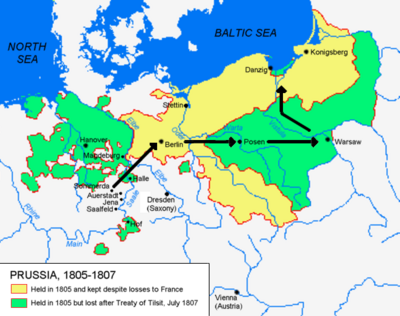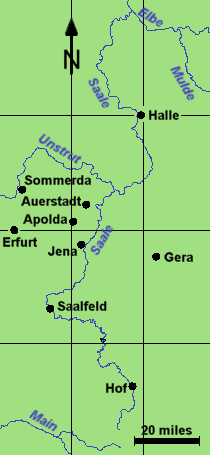Difference between revisions of "Hohenlohe"
m (→Biography) |
|||
| (4 intermediate revisions by 2 users not shown) | |||
| Line 1: | Line 1: | ||
[[Image:Friedrich Ludwig prince Hohenlohe-Ingelfingen.jpg|thumb|Prince Hohenlohe - 1806]] | [[Image:Friedrich Ludwig prince Hohenlohe-Ingelfingen.jpg|thumb|Prince Hohenlohe - 1806]] | ||
| − | {{People|name=Friedrich Ludwig Hohenlohe|dob=1746|service=Prussian Army|rank=General|nationality=Prussian|billets=}} | + | {{People|name=Friedrich Ludwig Hohenlohe|dob=January 31, 1746|service=Prussian Army|rank=General|nationality=[[Prussia|Prussian]]|billets=}} |
== Biography == | == Biography == | ||
| − | Friedrich Ludwig Hohenlohe, prince of Hohenlohe-Ingelfingen, was in charge of the | + | [[Image:Prussia_1805-1807.png|thumb|400px]] |
| + | [[Image:Saale-river-valley.png|thumb|210px]] | ||
| + | |||
| + | Friedrich Ludwig Hohenlohe, prince of Hohenlohe-Ingelfingen, was in charge of the [[Prussia|Prussian]] and Saxon troops assembled at Dresden, Saxony, when [[Temeraire]] and his crew arrived in their flight from Istanbul via Austria in September 1806. Hohenlohe was some sixty years of age at the time and, like many gentlemen of his day, wore a white powdered wig. | ||
| + | |||
| + | Hohenlohe initially demanded to know why [[William Laurence]] had not arrived with the 20 dragons promised to him by the British [[Aerial Corps]]. Of course Laurence, who had left Britain some nine months before, had no idea that such a promise had been made. Neither Laurence nor Hohenlohe knew that the [[Dragon Plague]] had stricken the Aerial Corps and that there were no dragons available to send. | ||
| + | |||
| + | Hohenlohe refused to grant Laurence and Temeraire a safe-conduct across Prussia until the promised dragons arrived, leaving it to Laurence's conscience to decide whether to spend the time waiting or to fight alongside the Prussians instead. Effectively, he requisitioned Temeraire. Laurence and Temeraire were assigned to the command of [http://en.wikipedia.org/wiki/Prince_Louis_Ferdinand_of_Prussia_(1772-1806) Prince Louis Ferdinand], commander of the advance guard. | ||
| + | |||
| + | The Prussians were defeated and Prince Louis Ferdinand killed on October 10, 1806, at the [[Battle of Saalfeld]]. Four days later, the Prussians were defeated even more resoundingly at the [[Battle of Jena-Auerstadt]]. Laurence and Temeraire fell back to Sommerda, where [[King Frederick]], [[Queen Louise]] and Prince Hohenlohe had gone. There was argument among the officers as to whether or not the bridges across the Elbe River ought to be destroyed to delay the French. At this point the King placed Hohenlohe in command of the army, instructing him to fall back on Magdeburg to gather the Prussian forces and consider how best to organize a defense along the Elbe. | ||
| + | |||
| + | Hohenlohe was shocked to learn that out of 14 Prussian heavy-weight dragons, none were left. He had no means to continue to force Temeraire to stay, but Laurence could not bring himself to desert the Prussians in this hour and instead asked for Hohenlohe's orders. Hohenlohe expressed no gratitude, but his face relaxed a little, and he asked Laurence to go to Halle, where the reserve troops were. | ||
| + | |||
| + | The French attacked Halle the next morning, before Laurence and Temeraire had even gotten underway. Hohenlohe instead asked Laurence to take the King and Queen to Berlin to join the royal children. They were still in Berlin when they received word that [http://en.wikipedia.org/wiki/Charles_XIV_John_of_Sweden Marshal Bernadotte] had taken Magdeburg, cutting Hohenlohe off, and that the French had crossed the Elbe before a single bridge could be destroyed. | ||
| + | |||
| + | After the children had been sent to presumed safety in Konigsberg - by early 1807, Napoleon had captured the two princes and taken them to Paris - Temeraire and Laurence continued on with the royal couple until they rejoined the Prussian army 20 miles west of Posen. In Posen, there was more news: Hohenlohe had surrendered the remnant of his army on October 28 at Prenzlau, 50 miles NNE of Berlin and 30 miles west of Stettin. | ||
| + | |||
| + | Hohenlohe spent two years as a prisoner of war in France, retired to his estates and lived in self-imposed obscurity until his death in 1818. | ||
| − | |||
[[Category:A-Z|Hohenlohe, Frederich Ludwig]] | [[Category:A-Z|Hohenlohe, Frederich Ludwig]] | ||
Latest revision as of 01:20, 12 November 2008
Character Profile[edit]
| Name: | Friedrich Ludwig Hohenlohe |
| Date of Birth: | January 31, 1746 |
| Service: | Prussian Army |
| Rank: | General |
| Nationality: | Prussian |
| Billets: |
Biography[edit]
Friedrich Ludwig Hohenlohe, prince of Hohenlohe-Ingelfingen, was in charge of the Prussian and Saxon troops assembled at Dresden, Saxony, when Temeraire and his crew arrived in their flight from Istanbul via Austria in September 1806. Hohenlohe was some sixty years of age at the time and, like many gentlemen of his day, wore a white powdered wig.
Hohenlohe initially demanded to know why William Laurence had not arrived with the 20 dragons promised to him by the British Aerial Corps. Of course Laurence, who had left Britain some nine months before, had no idea that such a promise had been made. Neither Laurence nor Hohenlohe knew that the Dragon Plague had stricken the Aerial Corps and that there were no dragons available to send.
Hohenlohe refused to grant Laurence and Temeraire a safe-conduct across Prussia until the promised dragons arrived, leaving it to Laurence's conscience to decide whether to spend the time waiting or to fight alongside the Prussians instead. Effectively, he requisitioned Temeraire. Laurence and Temeraire were assigned to the command of Prince Louis Ferdinand, commander of the advance guard.
The Prussians were defeated and Prince Louis Ferdinand killed on October 10, 1806, at the Battle of Saalfeld. Four days later, the Prussians were defeated even more resoundingly at the Battle of Jena-Auerstadt. Laurence and Temeraire fell back to Sommerda, where King Frederick, Queen Louise and Prince Hohenlohe had gone. There was argument among the officers as to whether or not the bridges across the Elbe River ought to be destroyed to delay the French. At this point the King placed Hohenlohe in command of the army, instructing him to fall back on Magdeburg to gather the Prussian forces and consider how best to organize a defense along the Elbe.
Hohenlohe was shocked to learn that out of 14 Prussian heavy-weight dragons, none were left. He had no means to continue to force Temeraire to stay, but Laurence could not bring himself to desert the Prussians in this hour and instead asked for Hohenlohe's orders. Hohenlohe expressed no gratitude, but his face relaxed a little, and he asked Laurence to go to Halle, where the reserve troops were.
The French attacked Halle the next morning, before Laurence and Temeraire had even gotten underway. Hohenlohe instead asked Laurence to take the King and Queen to Berlin to join the royal children. They were still in Berlin when they received word that Marshal Bernadotte had taken Magdeburg, cutting Hohenlohe off, and that the French had crossed the Elbe before a single bridge could be destroyed.
After the children had been sent to presumed safety in Konigsberg - by early 1807, Napoleon had captured the two princes and taken them to Paris - Temeraire and Laurence continued on with the royal couple until they rejoined the Prussian army 20 miles west of Posen. In Posen, there was more news: Hohenlohe had surrendered the remnant of his army on October 28 at Prenzlau, 50 miles NNE of Berlin and 30 miles west of Stettin.
Hohenlohe spent two years as a prisoner of war in France, retired to his estates and lived in self-imposed obscurity until his death in 1818.


